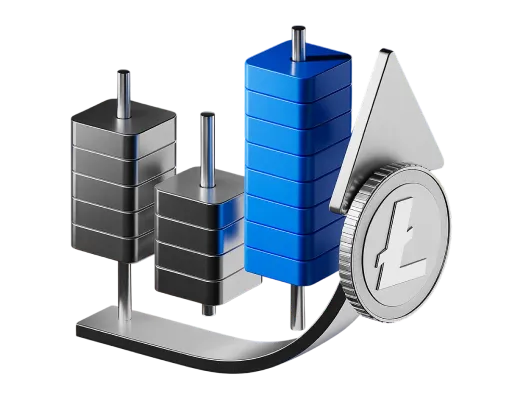How to Trade Litecoin: Step-by-Step for Beginners

As one of the earliest cryptocurrencies, Litecoin is often considered a solid choice for those new to trading digital assets. This guide covers essential tips, key trading terminology, and a step-by-step process to help beginners start trading Litecoin.
What Does It Mean to Trade Litecoin?
Trading Litecoin involves buying and selling the cryptocurrency to generate a profit. This requires monitoring price movements and market trends to make informed decisions.
You can trade Litecoin in two primary ways. The first is spot trading, where you buy or sell Litecoin at its current market price. The second is futures trading, which involves agreeing to trade at a speculative price on a predetermined date.
Spot trading carries less risk and is generally recommended for beginners. Futures trading, while potentially more profitable, involves higher risk and is better suited for experienced traders with a greater risk tolerance.
Key Trading Terms Every Beginner Should Know
Understanding common crypto trading terms is essential for making informed decisions and navigating the market effectively. Here are some of the most important terms to know:
- Altcoins: An abbreviation for "alternative coins," this term refers to all cryptocurrencies other than Bitcoin.
- Arbitrage Trading: The strategy of buying a cryptocurrency on one exchange and selling it on another to profit from price differences between the two platforms.
- Bear Market: A period characterized by a sustained and significant decline in cryptocurrency prices.
- Bull Market: A period characterized by a sustained and significant rise in cryptocurrency prices.
- Candlestick Chart: A graphical representation of an asset's price movements over a specific period, where each "candle" shows the open, high, low, and close prices.
- Day Trading: A strategy that involves buying and selling cryptocurrencies within the same day to profit from short-term price fluctuations.
- Exchange: An online platform where users can buy, sell, and trade cryptocurrencies.
- FUD: An acronym for Fear, Uncertainty, and Doubt, referring to the spread of negative information (true or false) to drive down an asset's price.
- FOMO: An acronym for Fear of Missing Out, describing the emotional urge to buy an asset after its price has already increased, often leading to poor decisions.
- HODL: A popular crypto slang term meaning to hold onto a cryptocurrency for the long term, regardless of price volatility.
- Gas Fees: The fees required to conduct a transaction or execute a contract on a blockchain network.
- Limit Order: An order to buy or sell a cryptocurrency at a specific price or better. The order only executes if the market price reaches the limit price.
- Long Position: A trading position where a trader buys a cryptocurrency with the expectation that its price will increase.
- Market Order: An order to buy or sell a cryptocurrency immediately at the best available current market price.
- Order Book: A real-time list of all open buy and sell orders for a specific cryptocurrency on an exchange.
- Scalping: A high-frequency trading strategy that aims to profit from very small price changes over numerous trades.
- Short Position: A trading position where a trader sells a cryptocurrency (often borrowed) with the expectation that its price will decrease, allowing them to buy it back later at a lower price.
- Stop-Loss: An order placed to automatically sell a cryptocurrency when it reaches a certain lower price, used to limit potential losses.
- Swing Trading: A strategy focused on capturing price swings over a period of days or weeks.
- Take-Profit: An order that automatically closes a profitable position once a specific price target is reached.
- Volatility: The measure of how much the price of a cryptocurrency fluctuates over time. High volatility means prices can change dramatically.
- Wallet: A digital tool used to securely store, send, and receive cryptocurrencies.
Step-by-Step: How to Trade Litecoin
For beginners, trading Litecoin can be straightforward by following a few key steps.
Choose a Crypto Exchange Platform
Litecoin is available for trading 24/7 on numerous cryptocurrency exchanges. As a beginner, prioritize platforms known for their security, reliability, and low fees. A good exchange will offer a user-friendly interface and support for various payment methods.
Create an Account
Once you select an exchange, you'll need to create an account. This typically involves providing personal details and completing a verification process, often known as Know Your Customer (KYC), to comply with regulations.
Fund Your Account
After your account is verified, you can deposit funds. Most exchanges allow you to deposit other cryptocurrencies or fund your account with fiat currency (like USD or EUR) via credit cards, debit cards, or bank transfers.
Select a Trading Pair
To trade Litecoin, you'll need to find the correct trading pair. For example, if you deposited Bitcoin, you would use the LTC/BTC pair. If you deposited US dollars or a stablecoin like USDT, you would use the LTC/USD or LTC/USDT pair.
Place an Order
Navigate to the trading section of the exchange to place an order. You can choose a market order to buy LTC instantly at the current price or a limit order to set a specific price at which you wish to buy.
Set Up a Litecoin-Compatible Wallet
While you can store your coins on the exchange, it is highly recommended to transfer them to a personal wallet for long-term holding. This gives you full control over your assets. Wallets come in various forms, including hardware wallets, software wallets (desktop or mobile), and web wallets.
Trading Examples for Beginners
Trading can occur on a cryptocurrency exchange or through an online broker. Here are examples of how each works.
Litecoin Trading on a Crypto Exchange
Imagine Litecoin is trading at $100. You decide to buy 2 LTC for $200. If the price rises to $110, your 2 LTC are now worth $220, giving you a $20 profit if you sell. This is an example of spot trading.
Conversely, if the price drops to $90, your 2 LTC would be worth $180, representing a $20 loss. You could sell to prevent further losses or hold in anticipation of a price recovery.
You can also use limit orders for more control. A buy limit order allows you to automatically purchase LTC if its price drops to a level you specify (e.g., $95). A sell limit order lets you automatically sell your LTC if the price rises to your target (e.g., $120), securing your profit.
Litecoin Trading with an Online Broker
Online brokers act as intermediaries, giving you access to financial markets. One way to trade Litecoin through a broker is with a Contract for Difference (CFD), which is a financial product that tracks the price of an underlying asset like Litecoin.
With a CFD, you speculate on price movements without owning the actual cryptocurrency. CFDs also allow for leverage, meaning you can control a larger position with a smaller amount of capital. For example, with $100, you might be able to open a leveraged CFD position equivalent to owning 5 LTC.
If you predict the price will rise and it does, your profits are magnified. However, leverage also magnifies losses, making it a high-risk strategy that is more suitable for experienced traders.
Tips for First-Time Litecoin Traders
Here are some valuable tips for trading Litecoin as a newcomer.
Choose a Reliable Exchange
Before selecting an exchange, research its security measures, user reviews, customer support, and trading volume.
Conduct Your Own Research
It is crucial to analyze market conditions, trends, and the fundamentals of Litecoin before executing a trade. Never rely solely on the advice of others.
Learn Basic Technical Analysis
Understanding how to read LTC price charts and use simple technical indicators can help you identify market trends and potential entry or exit points.
Stay Informed
Keep up with the latest news and developments in the cryptocurrency industry and broader financial markets to make well-informed trading decisions.
Use Strong Security Practices
Protect your exchange account and wallet with a strong, unique password and enable multi-factor authentication (MFA).
Set Realistic Goals
Define clear and achievable investment goals. Assess your available capital and determine your risk tolerance before you start trading.
Never Share Your Private Keys
Your private keys give complete access to your crypto wallet. Keep them offline and never share them with anyone.
Be Wary of Phishing Scams
Scammers often use fake links to trick you into revealing your private keys or login credentials. Always double-check website URLs and be skeptical of unsolicited offers.
Diversify Your Portfolio
The crypto market is volatile. Avoid putting all your funds into a single asset. Diversification can help mitigate risk.
Manage Your Risk
A common rule in the crypto space is to only invest what you can afford to lose. Consider using stop-loss orders to limit potential losses on trades.
Benefits of Trading Litecoin
While the primary goal of trading is profit, Litecoin offers several distinct advantages.
Established History
Launched in 2011, Litecoin is one of the oldest and most established cryptocurrencies, with a long track record of operation and development.
Faster Transactions and Lower Fees
Compared to Bitcoin, the Litecoin network confirms transactions faster and typically has lower fees, making it efficient for smaller, everyday payments.
Widespread Adoption
Litecoin is accepted by many merchants and payment platforms worldwide and is listed on nearly every major cryptocurrency exchange, ensuring high liquidity.
Shared Origins with Bitcoin
Litecoin was created from a fork of Bitcoin's code and shares many of its core principles, such as a Proof-of-Work consensus mechanism and a fixed supply. Its price often shows a correlation with Bitcoin's market movements.
Active Community
Litecoin has maintained a large and dedicated community of users, developers, and supporters who contribute to its network security and ongoing development.
Risks of Trading Litecoin
Despite its benefits, trading Litecoin involves risks that new traders must understand.
Competition with Other Altcoins
Litecoin faces stiff competition from thousands of other altcoins, many of which offer more advanced features or have gained more recent market attention.
Slower Pace of Development
Compared to newer projects, Litecoin's development can be perceived as slower. While this contributes to its stability, it may also limit its ability to innovate and adapt to new technological standards.
Market Volatility
Like all cryptocurrencies, Litecoin is subject to high price volatility. Its value can experience significant fluctuations in a short period due to market sentiment, regulatory news, or macroeconomic factors.
Conclusion
Litecoin remains a popular and accessible investment option for beginners due to its long history, lower fees, and widespread availability. However, the cryptocurrency market is inherently volatile. Developing a clear trading strategy, managing risk, and conducting thorough research are essential steps to maximize your chances of success and mitigate potential losses.
Disclaimer: This article is for informational purposes only and does not constitute investment advice. Always conduct your own research and consult with a professional before making financial decisions. All trading involves risk.

 Roman Klochko
Roman Klochko